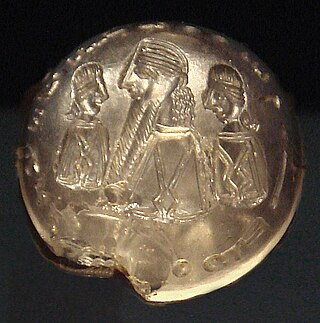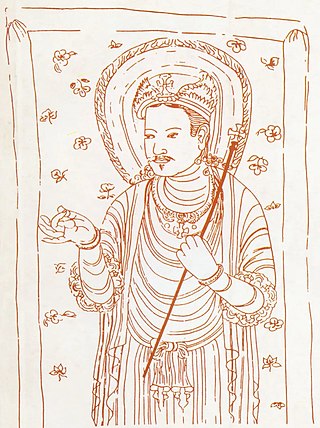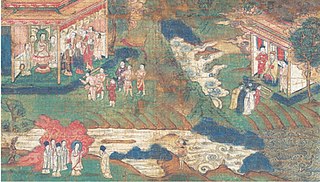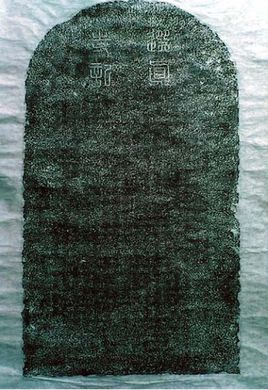
Manichaeism is a former major world religion, founded in the 3rd century CE by the Parthian prophet Mani, in the Sasanian Empire.

Xiapu is a county in the municipal region of Ningde, Fujian, People's Republic of China, located along a stretch of East China Sea coast, with many harbours and islands. It is bordered by Fuding City and Zherong County to the north, Fu'an City and Ningde's urban area to the west, and Luoyuan County, Fuzhou and the Matsu Islands of Lienchiang County, Republic of China (Taiwan) to the south.

Cao'an is a temple in Jinjiang, Fujian, Luoshan Subdistrict. Originally constructed by Chinese Manichaeans, it was considered by later worshipers to be a Buddhist temple. This "Manichaean temple in Buddhist disguise" had historically been seen by modern experts on Manichaeism as "the only Manichaean building which has survived intact". However, other Manichaean buildings have survived intact, such as the Xuanzhen Temple, also in China. In 2021, Cao'an was inscribed on the UNESCO World Heritage List along with many other sites near Quanzhou because of its unique testimony to the exchange of religious ideas and cultures in medieval China. Over 2022, the number of tourists to the location doubled and preservation efforts began.

Chinese Manichaeism, also known as Monijiao (Chinese: 摩尼教; pinyin: Móníjiào; Wade–Giles: Mo2-ni2 Chiao4; lit. 'religion of Moni') or Mingjiao (Chinese: 明教; pinyin: Míngjiào; Wade–Giles: Ming2-Chiao4; lit. 'religion of light or 'bright religion'), is the form of Manichaeism transmitted to and currently practiced in China. Chinese Manichaeism rose to prominence during the Tang dynasty and despite frequent persecutions, it has continued long after the other forms of Manichaeism were eradicated in the West. The most complete set of surviving Manichaean writings were written in Chinese sometime before the 9th century and were found in the Mogao Caves among the Dunhuang manuscripts.
The Manichaean Diagram of the Universe is a Yuan dynasty silk painting describing the cosmology of Manichaeism, in other words, the structure of universe according to Manichaean vision. The painting in vivid colours on a silk cloth survives in three parts, whose proper relation to one another and digital reconstruction was published by Zsuzsanna Gulácsi.

Sermon on Mani's Teaching of Salvation is a Yuan dynasty silk hanging scroll, measuring 142 × 59 centimetres and dating from the 13th century, with didactic themes: a multi-scenic narrative that depicts Mani's Teachings about the Salvation combines a sermon subscene with the depictions of soteriological teaching in the rest of the painting.

The Manichaean Painting of the Buddha Jesus (Chinese: 夷數佛幀; pinyin: Yí shù fó zhēn; Wade–Giles: I2-shu4 fo2-chên1; Japanese: キリスト聖像; rōmaji: Kirisuto Sei-zō; "Sacred Image of Christ"), is a Chinese Southern Song dynasty silk hanging scroll preserved at the Seiunji Temple in Kōshū, Yamanashi, Japan. It measures 153.5 cm in height, 58.7 cm in width, dates from the 12th to 13th centuries, and depicts a solitary nimbate figure on a dark-brown medieval Chinese silk. According to the Hungarian historian Zsuzsanna Gulácsi, this painting is one of the six documented Chinese Manichaean hanging scrolls from Zhejiang province from the early 12th century, which titled Yishu fo zhen (lit. "Silk Painting of the Buddha [Prophet] Jesus").
Manichaean scripture includes nine main books: the Seven Treatises of Manichaeism, all personally written by Mani in Syriac, the Shabuhragan written by Mani in Middle Persian, and the Arzhang, a series of illustrations painted by Mani.

In Manichaeism, Jesus is considered one of the four prophets of the faith, along with Zoroaster, Gautama Buddha and Mani. He is also a "guiding deity" who greets the light bodies of the righteous after their deliverance.

Manichaean Temple Banner Number "MIK Ⅲ 6286" is a Manichaean monastery flag banner collected in Berlin Asian Art Museum, made in the 10th century AD. It was found in Xinjiang Gaochang by a German Turpan expedition team at the beginning of the 20th century. The flag streamer is 45.5 cm long and 16 cm wide, with painted portraits on both sides. It is a funeral streamer dedicated to the deceased Manichae believers.

The three Persian religions, as a medieval Chinese concept, referred to a group of Iranian religions that spread to Tang China. They were recognized and protected under Tang rule, helping them to prosper in China at a time when Sassanid Iran was falling to the early Muslim conquests. The three religious movements identified by the term were Zoroastrianism, the Persian Church, and Manichaeism.
Master Ulug was a Uyghur Manichaean missionary in the Tang Dynasty

The Birth of Mani is a Manichean silk cloth color painting painted in the Fujian Zhejiang area during the Yuan period, depicting the founder of the sect Mani The scene of birth, a scholar who specializes in Manichaeism Ma Xiaohe called it "a rare treasure". This picture is now in the collection of Japan Kyushu National Museum. The drawing technique and artistic style are similar to "Mani's Community Established" and "Mani's Parents", "The Birth of Mani" and "Manichean Universe Map". " It was originally part of a large-scale Manichean silk painting, but now the silk painting has been lost, leaving only the birth picture.
Icon of Mani is a silk painting hanging scroll from the Yuan or Ming period, from the coastal area of southern China, depicting Mani. The portrait of the founder Mani has been completely Sinicized.
The Xiapu Manichaean manuscripts are Chinese Manichaean manuscripts from Shangwan Village 上万村, Baiyang Township, Xiapu County, Fujian Province, China. They first became known to academia and the general public in October 2008. Today in Baiyang Township, the texts are used for rituals conducted for Lin Deng 林瞪 in the three villages of Baiyang 柏洋村, Shangwan 上万村, and Tahou 塔后村.

Mani's Community Established is a Manichaen silk color painting drawn in the coastal area of southern China during the yuan to ming period, depicts the missionary history of Manichaeism and the establishment of its churches in three scenes. The preservation is intact and undamaged. This painting was originally part of a large Manichae silk painting, The drawing technique and artistic style are very similar to "Episodes from Mani's Missionary Work", "The Birth of Mani", "Mani's Parents" and "The Manichean Universe Map". The painting is now in a private collection in Japan.

The Cangnan Stele is the temple stele of the Yuan Dynasty Manichaean monastery Xuanzhen Temple (选真寺). It is the only Manichean stone monument found in the world so far. The stele has been listed in China as a national second-class cultural relic, now in the Cangnan County Museum, in Zhejiang Province. The monument is 150 cm high, 76 cm wide, and 10 cm thick, half on the forehead of the round stele; the inscription is inscribed in seal script, "Xuansiji". Lin Wushu called the Xuanzhen Temple according to the inscription "It was built by the church of the neighboring countries of Jiangsu, and was built before the Gai Peng family." It means that the Mingjiao of Xuanzhen Temple still inherits the tradition of Manichaeism in the Tang Dynasty, influenced by foreign religions, and is different from ordinary folk religions.

Manichaeism has a rich tradition of visual art, starting with Mani himself writing the Book of Pictures.

In Manichaeism, Siddartha Gautama is considered one of the four prophets of the faith, along with Zoroaster, Jesus and Mani. Mani believed that the teachings of Gautama Buddha, Zoroaster, and Jesus were incomplete, and that his revelations were for the entire world, calling his teachings the "Religion of Light".
Moni Guangfo is one of the longest and most important Xiapu Manichaean manuscripts. The manuscript contains 83 pages, 659 lines, and over 8,300 Chinese characters in total. The text was discovered by Chinese researchers in 2009 and belongs to Chen Peisheng 陈培生, a priest or ritual master in Shangwan Village 上万村, Baiyang Township, Xiapu County, Fujian Province, China.



















